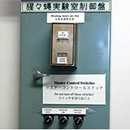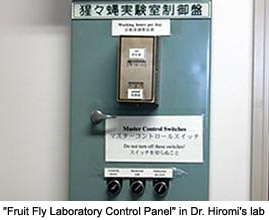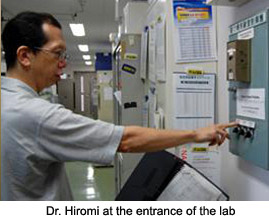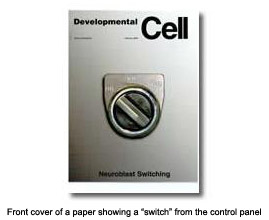HIROMI, Yasushi D. Sc., Professor

- Department of Developmental Genetics, Division of Developmental Genetics, Hiromi Lab. Research Theme: Developmental genetics of organogenesis
Starting a new educational program at NIG
Before joining NIG Prof. Yasushi HIROMI spent a total of 13 years outside Japan, first as a postdoctoral fellow (Switzerland and US) and then as a faculty at Princeton University. Upon returning to Japan, he wanted to do something to make use of his experience abroad. He had noticed that the excellence and impact of research done in Japan is often not readily visible in the publications made by Japanese researchers. With this awareness, he started a new educational program at NIG, to help future researchers to be active on a global scale.
- Encounter with Genetics
 Dr. Hiromi’s laboratory studies mechanisms and principles of neural development: the generation of diverse neurons from neural stem cells, and the construction of neural circuit through axon guidance. They use fruit flies (Drosophila melanogaster) as an experimental organism. “There’re two types of researchers who use fruit flies,” he says, “those who have loved insects since childhood, and those who seek to understand the logics that govern various phenomena.” Strong in physics and mathematics and majoring in physics as an undergraduate, Dr. Hiromi definitely belongs to the second type.
Dr. Hiromi’s laboratory studies mechanisms and principles of neural development: the generation of diverse neurons from neural stem cells, and the construction of neural circuit through axon guidance. They use fruit flies (Drosophila melanogaster) as an experimental organism. “There’re two types of researchers who use fruit flies,” he says, “those who have loved insects since childhood, and those who seek to understand the logics that govern various phenomena.” Strong in physics and mathematics and majoring in physics as an undergraduate, Dr. Hiromi definitely belongs to the second type.- Dr. Hiromi’s interest in genetics was first triggered when he was an undergraduate student at the University of Tokyo, by a 1972 article in Nature written by Yoshiki Hotta, currently Professor Emeritus at the University of Tokyo. The article described, at the time when there were no molecular biological techniques to analyze genes, how to apply techniques of “classical” genetics to determine the part of the body where individual genes must be expressed in order to control higher functions such as development and behavior. Dr. Hiromi was impressed with the extent to which logical thinking could lead a deep understanding of complex biological phenomena. He decided to pursue his graduate research under Prof. Hotta.
- Making the most of his personal value
 After obtaining his Ph.D., he continued research abroad, first as postdoctoral fellow and then as assistant professor at Princeton University. It was then when he was recruited to NIG as full professor. Dr. Hiromi thinks he may be the NIG’s record holder for the smallest number of publications at the time of appointment as professor. Apparently NIG recognized that his caliber cannot be measured merely by the number of publications.
After obtaining his Ph.D., he continued research abroad, first as postdoctoral fellow and then as assistant professor at Princeton University. It was then when he was recruited to NIG as full professor. Dr. Hiromi thinks he may be the NIG’s record holder for the smallest number of publications at the time of appointment as professor. Apparently NIG recognized that his caliber cannot be measured merely by the number of publications.- After joining NIG Dr. Hiromi asked himself how he could contribute to the Institute. Research, of course, but something else drawing on his experience abroad…. The answer was to start a new program to enhance scientific output from NIG. ”Even though there is no difference between Japan and Western countries in the quality of scientific research being conducted, there are differences in ways in which the results are made into a research paper, especially in the approach and reasoning. In the United States, young researchers undergo thorough training in scientific writing. “For scientists, the purpose of writing a paper is not to add one line to the publication list,” Dr. Hiromi says, “well-written papers stimulate other researchers and thereby produce useful feedback.”
- He proposed to hold a workshop on scientific writing, by inviting a lecturer from the US. “I was ready for negative reaction from my new colleagues, that I should be concentrating on doing research.” It turned out, however, that faculty was very supportive for such endeavor. Scientific Writing Workshop, held in 2000, attracted over 70 participants, of which more than half was faculty. This was the beginning of courses on scientific writing and presentation — now a hallmark of NIG graduate education.
- Nuturing originality = personality
 On the wall of Dr. Hiromi’s laboratory is a “Fruit Fly Laboratory Control Panel,” on which three switches —“Creativity”, “Bench work” and “Publication” — are kept “ON” at all times. This playful arrangement is the proof of Dr. Hiromi’s solid commitment to research and education. “There are things you can teach to your students and things you can’t. I don’t think there’s a way one can teach originality.” Originality is a reflection of personality, so he wants to help his students “develop” their originality, rather than trying to teach it. He does this by engaging students into dialogs, and enticing them to think deeply. Likewise, he runs the Developmental Biology course in a similar way, by discussing over original research article, not only to understand the contents, but also to seek new directions and challenges that the results generate. An educational curriculum that caters a large number of students is efficient, but it is more important to create an educational framework that can draw out the best of each student’s potential. At NIG, with an excellent educational and research environment, Dr. Hiromi now stands at the heart of its education program.
On the wall of Dr. Hiromi’s laboratory is a “Fruit Fly Laboratory Control Panel,” on which three switches —“Creativity”, “Bench work” and “Publication” — are kept “ON” at all times. This playful arrangement is the proof of Dr. Hiromi’s solid commitment to research and education. “There are things you can teach to your students and things you can’t. I don’t think there’s a way one can teach originality.” Originality is a reflection of personality, so he wants to help his students “develop” their originality, rather than trying to teach it. He does this by engaging students into dialogs, and enticing them to think deeply. Likewise, he runs the Developmental Biology course in a similar way, by discussing over original research article, not only to understand the contents, but also to seek new directions and challenges that the results generate. An educational curriculum that caters a large number of students is efficient, but it is more important to create an educational framework that can draw out the best of each student’s potential. At NIG, with an excellent educational and research environment, Dr. Hiromi now stands at the heart of its education program.- (Interviewed by Leave a nest Co.,Ltd on Oct. 12, 2007)
















